AI vacuuming robot iRobot Roomba j7+ in test: The Tesla effect
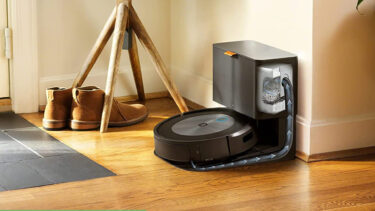
The iRobot Roomba j7+ vacuum robot faces the MIXED long-term test. Here is how it performs in terms of object detection, suction performance, and ease of use.
With the iRobot Roomba j7+, the robot vacuum experts launch a robot whose AI image analysis supposedly even recognizes poop. Instead of laser navigation, iRobot relies on a camera and artificial intelligence.
I tested the vacuum robot with computer vision for three months, both in everyday use and specifically in an obstacle course. In the end, the Roomba j7+ left an impression. Read why it did not make me completely happy in the following review.
Content
iRobot Roomba j7+: Review in a nutshell
The object recognition for small parts is really outstanding. And the range of functions as well as the usability via the smartphone app are exemplary. However, I was not completely convinced by the Roomba j7+. The vacuum robot does many things right. It also has a few small shortcomings that did not improve significantly over three months despite "AI learning".
Overall, it does not stand out decisively from the competition, which has more functions like a wiping function on board at a similar price. Despite some flaws, if you want a pure vacuum robot with strong suction power, a solid suction station and robust object recognition, you will hardly find a better device than the iRobot Roomba j7+.
Advantages of the iRobot Roomba j7+:
- excellent object detection for small parts such as cables, socks, etc.
- strong suction power even along edges
- almost maintenance-free main brush
- very easy setup and well-structured app
- many useful functions like automatic cleaning when leaving the house
- nice suction station with practical storage compartment for the suction bag
- obstacles detected via AI camera can be classified manually
Disadvantages of iRobot Roomba j7+:
- poor obstacle detection for larger objects like guitars, etc.
- frequent approach of furniture, walls, doors, etc.
- gets only badly into corners, which requires a lot of rework
- needs too many passes to clean a room over a wide area
- AI camera permanently fails to recognize some obstacles
- can only navigate precisely in bright rooms
iRobot Roomba j7+: Easy startup and precise mapping
Getting the iRobot Roomba j7+ up and running is a breeze and no problem even for newbies. The companion app automatically finds the new robot. It then guides me step-by-step through the setup process and provides tips and information about the features.
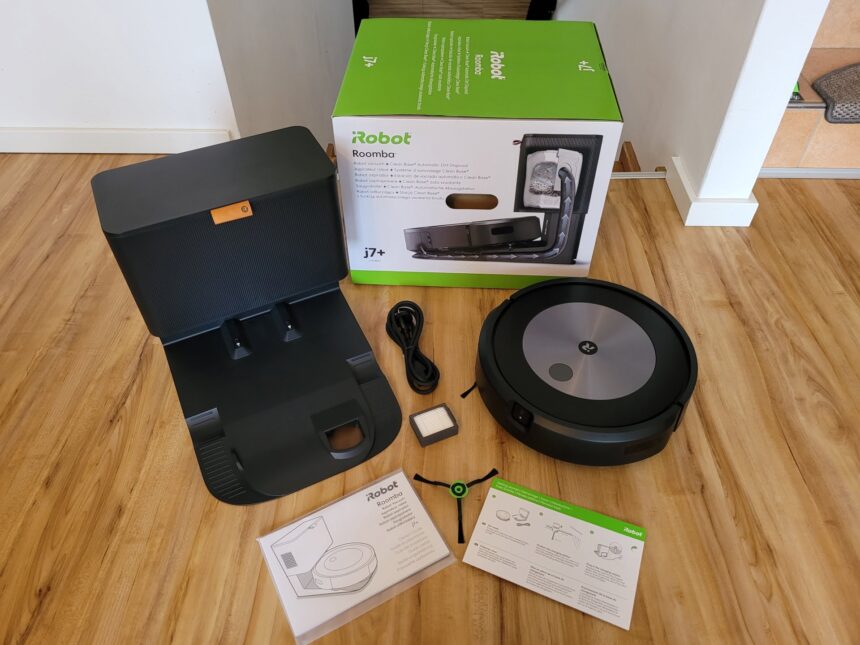
The iRobot Roomba j7+ comes with a suction station, a replacement brush, and a replaceable filter. | Image: iRobot / MIXED
Mapping a room requires at least two passes. If desired, it cleans in the process, but then it takes a bit longer. It can clean a 45-square-foot room in about 13 minutes per round.
During this phase, remove all small items and cables from the floor. Wobbly and fragile items are also better secured. The Roomba takes little notice during the mapping process, running over everything and ditching everywhere. The robot almost knocked my acoustic guitar out of its stand. Afterward, however, you have a very precise map of the surroundings.
Useful functions and practical app
The iRobot Roomba j7+ does everything a modern vacuum robot should. I can program schedules or have it clean automatically when I leave the house. The Roomba creates smart maps for several rooms, recognizes carpets on its own, and divides up each room sensibly. If that doesn't work as desired, I help it out manually.
I can also define certain cleaning zones. Roomba then cleans areas that tend to get dirty more often, such as the kitchen, dining area or entryway, specifically and several times a day if desired. The iRobot Roomba j7+'s companion app is sensibly structured and I find all the functions effortlessly.
On the main screen, I can set favorites and thus no longer have to go to the Smart Map to start recurring tasks such as approaching a certain cleaning zone, for example. In addition, there is a history that records the cleaning statistics of the Roombas in detail and provides various useful tips about the vacuum robot.
Suction performance in daily use: light and shadow
In daily use, the iRobot Roomba j7+ cleans decently. Its suction performance is indeed strong. There is hardly any dry dirt that it does not remove. However, it does not reach some areas.
In a dog or cat household, you'll have to clean up every few days, as hair and dust bunnies often collect in corners or around larger objects. A second cleaning brush might not have hurt.
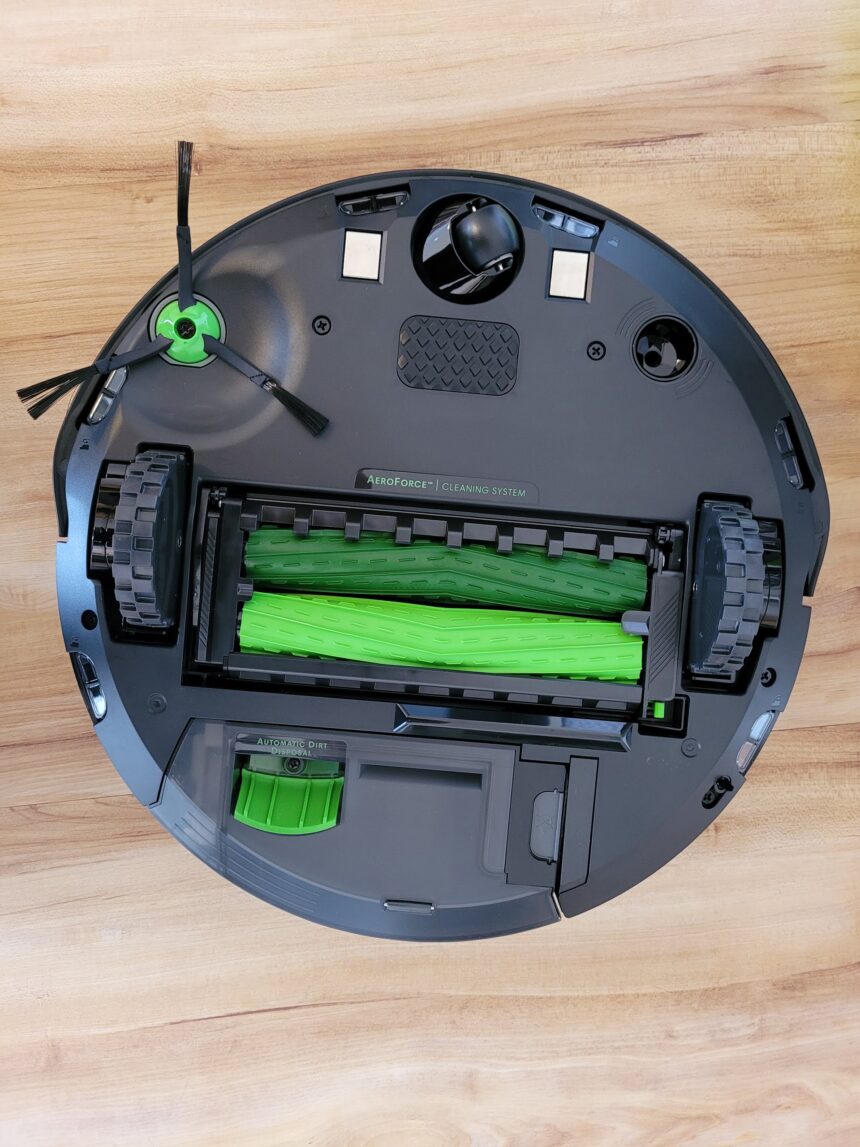
The main brush of the iRobot Roomba J7+ consists of two rubber rollers moving in opposite directions and is virtually maintenance-free. | Image: MIXED
The design of the main brush, on the other hand, is a stroke of genius. The two rubber rollers moving in opposite directions are virtually maintenance-free. I only had to remove a few hairs once in three months. Tangles and resulting interruptions to the cleaning process are a thing of the past.
Object and obstacle detection of the iRobot Roomba j7+ in the test
The iRobot Roomba j7+ relies on a camera with LED light bump and fall sensors for navigation. It does not have a lidar scanner like the Ecovacs Deebot T9+. The Roomba therefore always needs enough light to navigate properly. It glides effortlessly over edges and maneuvers safely along steps.
Upon request, I can sign up for "obstacle image verification". With its camera-based "PrecisionVision Navigation," it recognizes objects and obstacles, records them, and then queries them. This should help Roomba get to know its surroundings better and make its object detection more robust.
iRobot Roomba j7+: Obstacle detection in everyday use
I didn't have to return the Roomba to the charging station myself once in three months. In the living room with high pile carpet, narrow passages between couch and coffee table as well as a staircase downstairs, there were never any problems. Even under the sideboard with TV wiring (admittedly sloppily) attached underneath, it came out every time without causing any damage.
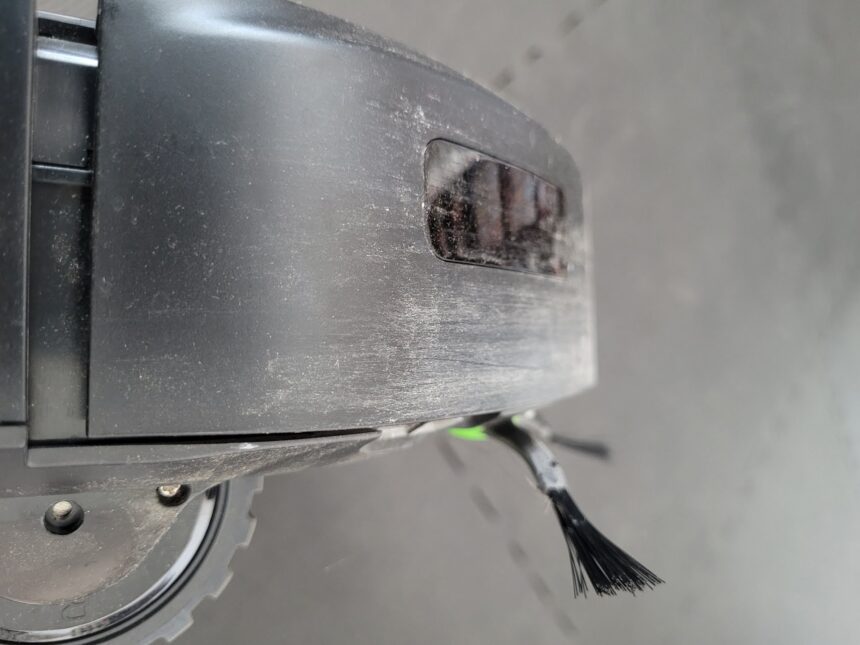
The iRobot Roomba j7+ starts up frequently. This is the result after three months. | Image: MIXED
The only flaw the Roomba j7+ has when it comes to obstacle detection is its penchant for hitting furniture, walls, and large objects. Although the AI helper recognizes many small objects and bypasses them effortlessly, it still greets our patio door with a white frame or the silver subwoofer with a hearty thump after three months.
Video: MIXED
In the video above, you can see how the Roomba j7+ maneuvers its way out from under a desk, barely missing an opportunity to bump into it. However, it recognizes the office chair at the end effortlessly. Here, no improvement was noticeable even after three months despite AI obstacle detection. The system without laser navigation does not seem to be mature yet.
iRobot Roomba j7+ in the MIXED office course
I collected pet hair for the Roomba j7+ for two months and spread it over the black plastic exercise mats in my VR room. Fortunately, some crumbs and other useful dirt were also found on the dog rugs to give the Roomba a worthy task. In addition, I placed a few small items, as they are likely to be found occasionally on most floors.
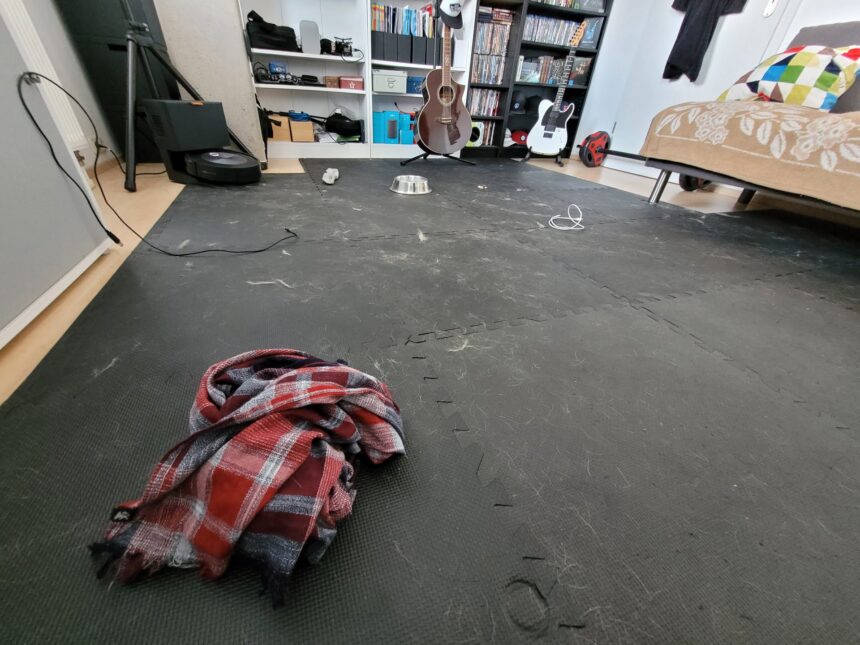
The iRobot Roomba j7+ had to face any amount of dog hair, a handful of peanuts, a food bowl, a sock, cables, and guitar stands. | Image: MIXED
Object detection is the iRobot Roomba j7+'s great strength. It usually avoids cables, dog bowls, and clothes unerringly. Be careful with small objects: It sucks away a handful of nuts like nothing. The Roomba records objects via its camera and presents them in the app after the first cleaning run.
There, I have the option of specifying whether the object is temporary or permanently placed. I am then told to clean up the first category so that the Roomba can vacuum the corresponding spots. This works perfectly. In the next pass, the robot moves to the places where objects were previously located without any problems.
What it couldn't locate in this test run were black tripod legs from guitar stands. It pushed the white electric guitar and stand a few centimeters across the room. It maneuvers under the sofa without any problems. The robot has a hard time with objects that hang about as high above the floor as the Roomba itself is tall. It almost lifted the acoustic guitar hanging in the stand several times.
This is a problem with valuable items like guitars, vases, or fragile decorations. The room delimiter function provides a remedy here. It's better to block such objects on the robot's smart card and briefly vacuum around yourself. Overall, however, the object detection for small items and pets is the strongest I have tested so far.
Results of the object detection in the office course with video
| Object | Obstacle detection | Minute in video |
| Sock | Approached, then detected and avoided | 00:52 / 05:33 / 09:12 |
| Cable (black) | Detected and bypassed | 00:46 / 07:33 |
| Food bowl | Detected and bypassed twice, bumped lightly on third and fourth times | 01:17 / 03:58 / 04:05 / 05:25 |
| Peanuts | Detected as dirt and sucked up | 04:12 |
| Cable (white) | Detected and bypassed | 01:36 / 03:47 |
| Scarf | Detected and bypassed once, not detected and approached the second time | 05:50 / 06:10 |
| Dog | Detected and bypassed | 05:57 / 11:05 |
| Electric guitar (white on black stand) | Not recognized and approached several times | 02:48 / 04:24 / 10:06 / 10:26 |
| Acoustic guitar (brown on black stand) | Not recognized and approached several times | 05:12 / 09:31 / 10:40 / 13:05 |
| Volume measurement during vacuuming | approx. 56 - 58.7 dB (corresponds to a quiet office) | 07:56 |
| Volume measurement of the suction station | Approx. 70 - 72 dB (corresponds to busy traffic) | 14:28 |
| Entering the charging station | Aimed unerringly and found | 13:30 |
Conclusion: iRobot Roomba j7+ in test
The iRobot Roomba j7+ does many things excellently. But, it has the same weaknesses as most vacuum robots of its generation.
It vacuums strongly, but needs at least three passes to clean a room of just under 45 square feet (ca. 4 m²), as it keeps skipping areas. It catches dirt along edges without any problems. However, pet hair and dust bunnies collect at corners over a longer period of time. Thus, it only does a decent job in everyday use. There are still too many spots that require reworking.
There is nothing to complain about in terms of workmanship, design and usability. Both the robot and the suction station are discreet and look good in the living room. iRobot's main brush technology is clever and rarely requires small maintenance handles. Bags in the suction station can be changed quickly and there is a handy compartment for spare bags.
The app is neatly structured and includes many practical features that are explained in an understandable way. There were only rare connection interruptions and occasionally the language changed on its own. Nothing that the next software update cannot fix.
In object recognition, the iRobot Roomba j7+ is excellent. It is probably the best in its class as long as it is dealing with small items like socks or cables. On the other hand, it has a hard time with larger objects. The fall sensors on stairs work flawlessly, but it regularly bumps into desks, guitar stands, or bright patio doors. Pets, on the other hand, seem safe from it.
It's worth waiting for offers, as the iRobot Roomba j7+ is clearly too expensive for an MSRP of $600. If you get the device with suction station for $800, it's a fair price.
Note: Links to online stores in articles can be so-called affiliate links. If you buy through this link, MIXED receives a commission from the provider. For you the price does not change.